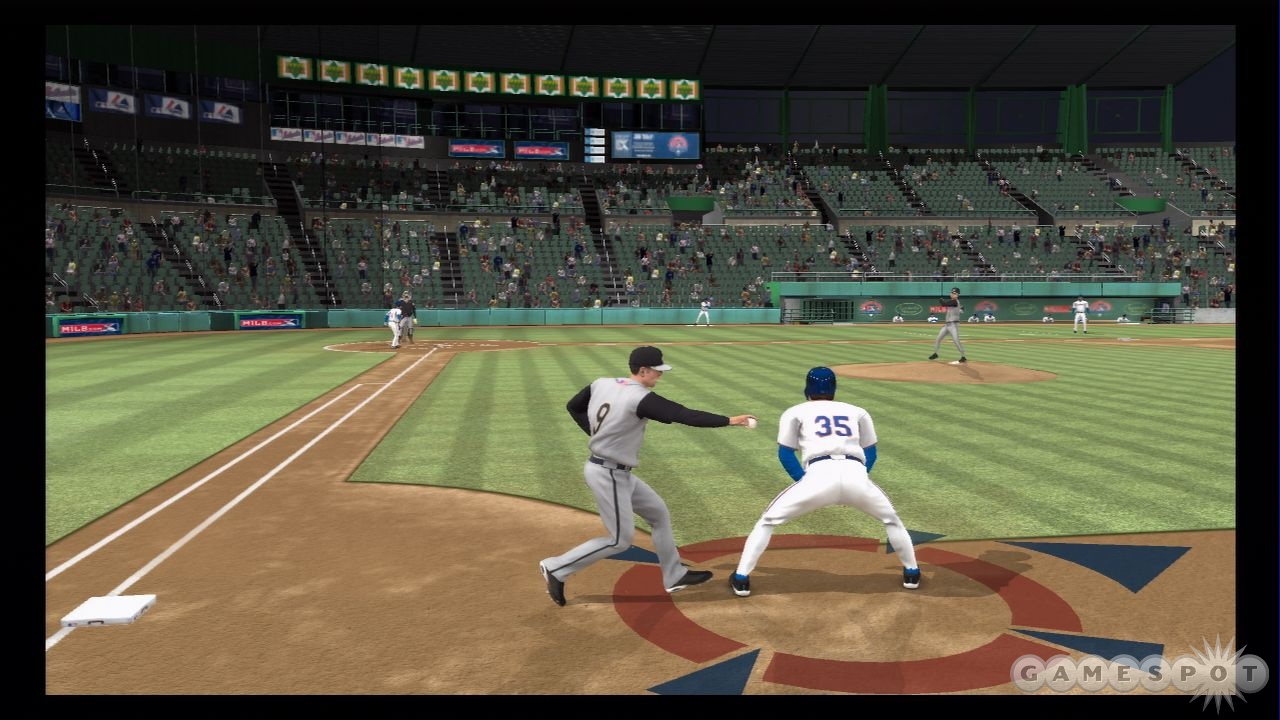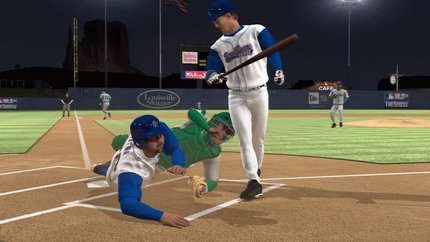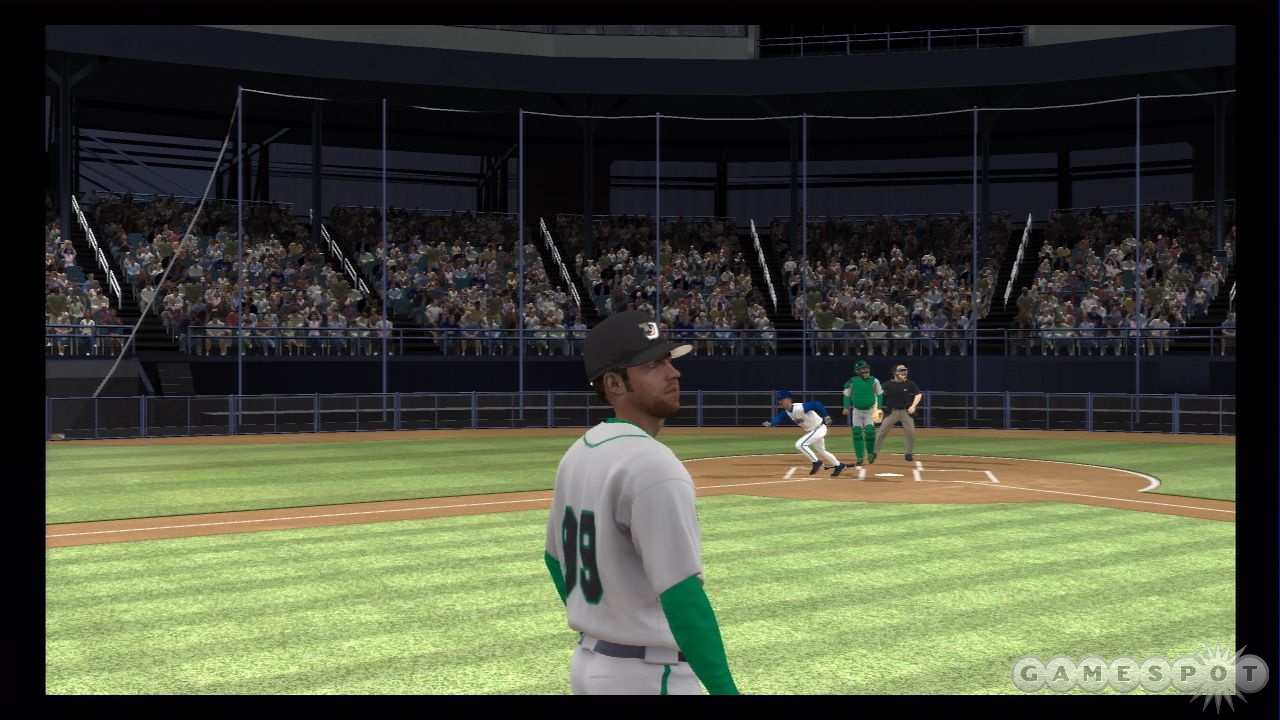MLB 08 The Show: Two Tales From the Road to the Show
The road to the big leagues starts here in our two-headed look at MLB 08's road-to-the-show mode.
Sony's MLB: The Show baseball series has long been the crown jewel of its sports games. Far from just great baseball games, the last few entries in the series have been fantastic sports games with excellent depth and features that are often ahead of their time. Consider the ever-evolving road-to-the-show mode, first introduced as a career mode in MLB 06. This year, the road to the show will provide you with even more feedback for your player progression and more to keep you busy as the season progresses. To illustrate, we've been playing through the road-to-the-show mode in our preview build of MLB 08 to give you two different perspectives on the mode: one from the infield and the other from the pitcher's mound.
Brian aka "Dirtbag"
Back in the halcyon Jason Giambi days, the Oakland A's brashly referred to themselves as "dirtbags," so its little wonder that I gave my created shortstop--who I added to the A's roster for spring training--the very same nickname. There's just something special about hearing MLB 08 play-by-play man Matt Vasgersian refer to you as "dirtbag" every time you come up to the plate. I'm a Cubs fan at heart, but because I wanted to play shortstop in road-to-the-show mode, your best bet for landing in the MLB is to find a team that's talent-thin at your chosen position, hence the decision to bring the Dirtbag back to the A's. Besides, if Dirtbag makes it big, I can always demand a trade on his behalf later.

One thing that the Sony MLB series has really nailed of late is getting you into the action that matters for your created player--and only the action that matters. Whether it's fast-forwarding to your next scheduled appearance (especially nice for pitchers) or taking you to the next play in a game that you are involved in, you're always engaged in MLB 08. That's definitely the case for Dirtbag; as a shortstop, it seems like you're either fielding the ball or covering second base several times per inning. It's a bit more interactive than playing, say, first base, where the majority of your defensive job involves, well, standing on first base.
So with more ground balls coming your way, you've got to be on your toes. This is especially true because Dirtbag probably isn't as fast as he needs to be in the game. Getting to line drives takes some quick reaction times, and as a result, I've decided to make speed a focal point for Dirtbag's spring-training routine. Doing so is simply a matter of spending the training points you earn over the course of a game from accomplishing various tasks put forth by your manager. These tasks include both defensive and offensive tasks, though it seems that the more specific tasks come when at bat. In one case, your manager is looking for a hit; in another, he might be looking to get the opposing pitcher's pitch count up and ask you to take a strike. In yet another, he might be literally begging you to find a way--any way--to get on base during a particularly bad dry streak.
Unfortunately for Dirtbag, dry streaks tend to be the norm for him, at least in the early goings of spring training. At the peak of his spring-training powers, Dirtbag was batting a healthy .308 with five runs batted in, but that quickly dipped to .245 after a long string of games without a hit--which was painted in clear black and white thanks to new and improved post-game player-progression screens that show you exactly how your player is improving (or not).
As it has been in the past, MLB 08's guess-the-pitch feature is very tempting when at bat. To guess a pitch, you simply press the R2 button and choose the type of pitch with a face button. You can also guess the location of the pitch with the analog stick. If you're successful at guessing the pitch type, location, or both, the strike zone will illuminate. A pitcher's favorite pitch types are tied to the X, circle, triangle, square, and shoulder buttons--in that order. So if you typically guess the X or circle pitch (whatever type it is), you'll find a good percentage of success.

Another bone of contention regarding Dirtbag is baserunning. It's all too tempting to use the shoulder buttons to get a few steps off of first base. However, if your reaction times aren't lightning-quick, the pitcher will pick you off with ease.
At the end of spring training, the A's organization offered Dirtbag a one-year contract with its Double A team: the Midland Rockhounds. According to the player progression, he's currently rated fifth out of five shortstops in the organization. Nevertheless, that didn't stop Dirtbag from demanding a two-year contract with the Rockhounds. My guess is that he might need even more time in the minors before he's ready for the big show.
Shanker aka "Shank Dogg"
When I was initially contemplating my starting pitcher creation, I wanted to choose a name that would strike fear into anyone who stepped into the batter's box. I wanted a name that conveyed a willingness to deliver some chin music to batters brash enough to crowd the plate. I envisioned someone right out of the mold of a 'roid-raging Roger Clemens or half-blind Ricky Vaughn. In the end, though, I decided against Heater Von Pegsalot and just named him Shank Dogg (luckily "dawg" is one of the available nicknames).
As far as pitch selection went, Shank Dogg obviously needed his signature four-seam fastball. I rounded him out with a slider and sinker in order to cajole chasing from batters waiting on the heater. This was, at least, the theory going in.
Although every major-league team seemed content with its existing rotations, this was misleading. After all, Shank Dogg needs only to be better than the worst guy on the rotation to earn his starting gig. As a tribute to my hometown, I decided to have Dogg try out for the Seattle Mariners.
Spring training didn't start out as smoothly for Shank Dogg as I would have hoped. Just days into my tryout, I was plugged into the starting rotation, facing the likes of Manny Ramirez and David Ortiz. Even worse, Dogg's "overpowering" fastball was only clocking in the low 80s; not something that was going to intimidate any big-league players. As a result, I made bumping up the velocity of Dogg's four-seamer a top priority.
After getting shelled during his first two starts (11 earned runs in just eight innings of work), Shank Dogg started to fall into a groove. Although he would see only four or five innings of work because of his low stamina and high pitch counts, he managed to rack up back-to-back player-of-the-game honors, pitching nine straight scoreless innings. Admittedly, he had a lot of help from Ichiro's range in centerfield. Shank Dogg was well on his way to signing a big-time contract and leaving his mark on the sport of baseball.
Then the Cubs came to town. In Shank Dogg's final start before contract negotiations, he had his worst outing yet. One main issue was Dogg's inability to retire batters quickly. Often, long batter/pitcher duels would result in Dogg throwing 10 to 15 pitches before walking the batter or having someone line one into the gap. Yeah, Dogg had some control issues (just adds to his mystique), but he was definitely getting hosed by the home-plate umpire. This only compounded the problem because Dogg's low clutch rating made him even more erratic with runners on base.

Finally, with Soriano coming up to bat for the third time in the top of the second inning, Shank Dogg lost his composure. Frantic to find the umpire's strike zone, Dogg popped Soriano in the head with an errant (half-intended) fastball. Soriano shook off the cobwebs before taking his base without incident. After the next two batters hit the dirt with dented helmets, though, Shank Dogg was finally thrown from the game. I regretted it right afterward, but after more reflection, I rationalized that that's the sort of mentality it takes to earn a reputation in this league.
After a series of negotiations in which the Mariners organization repeatedly tried to lowball Shank Dogg, the two parties agreed to a one-year, $35,000 contact (heh, suckers), and Dogg found himself on the Mariners' AA squad, the West Tennessee Diamond Jacks.
Because of Dogg's low endurance rating, the manager decided to only bring Dogg in to middle relief and ranked Dogg as the 14th best option among the 16 active pitchers on the roster. The guy clearly hadn't seen Dogg's earlier work during spring training. The only situation in which Dogg would see action was when the Diamond Jacks were getting crushed in the fourth or fifth inning with no hope of a rally. Luckily, the team seemed lousy enough for Dogg to get his opportunity. Here's to ending a few minor-league careers...
Stay tuned for more tales of Dirtbag and Shank Dogg in our next look at MLB 08: The Show.
Got a news tip or want to contact us directly? Email news@gamespot.com
Join the conversation